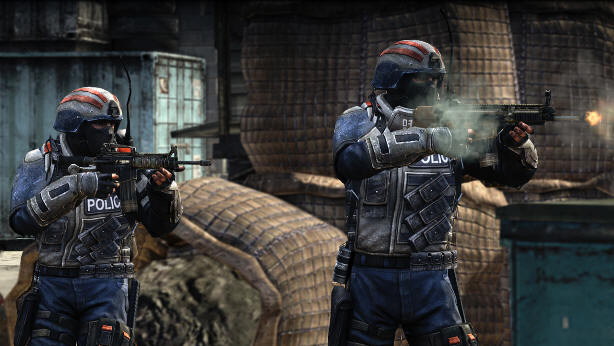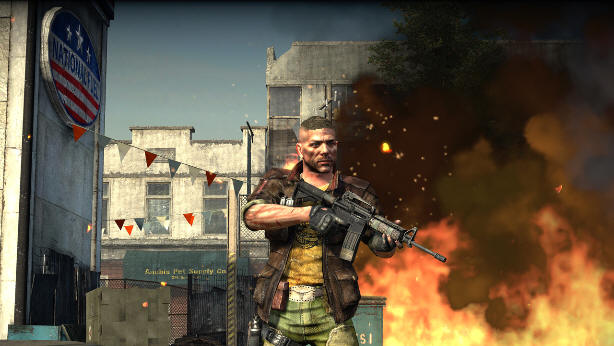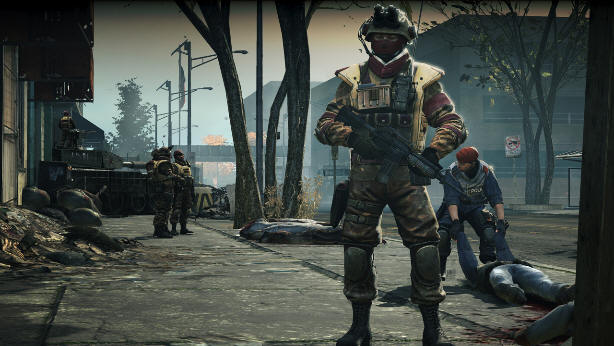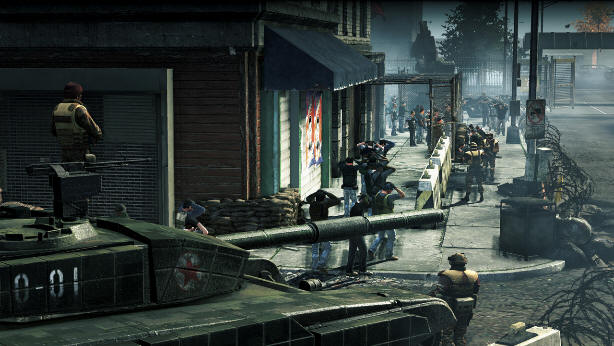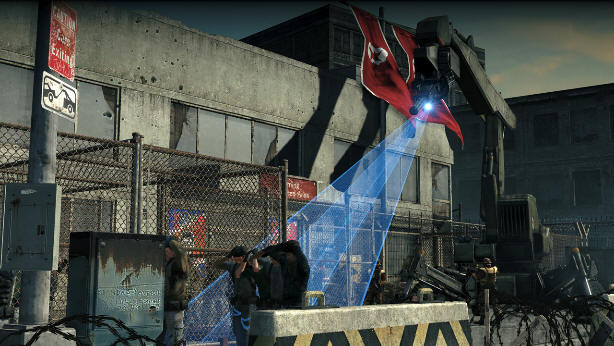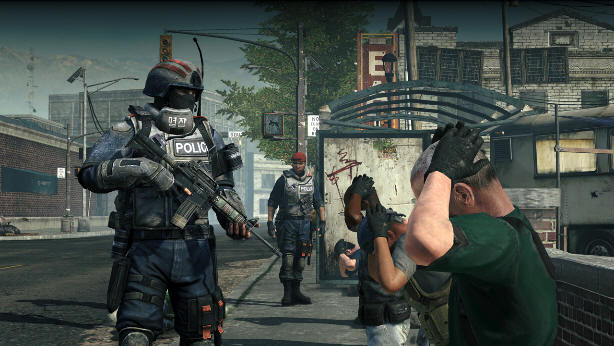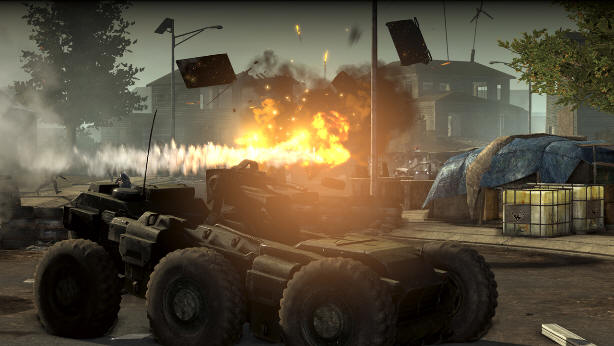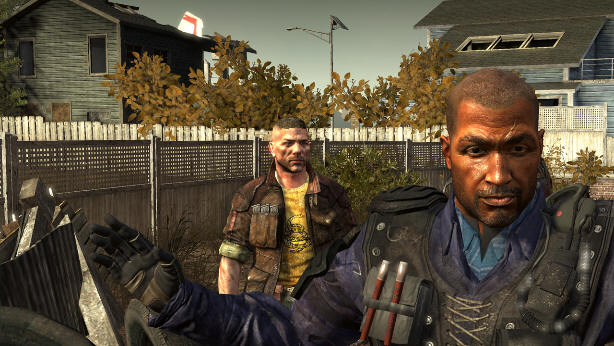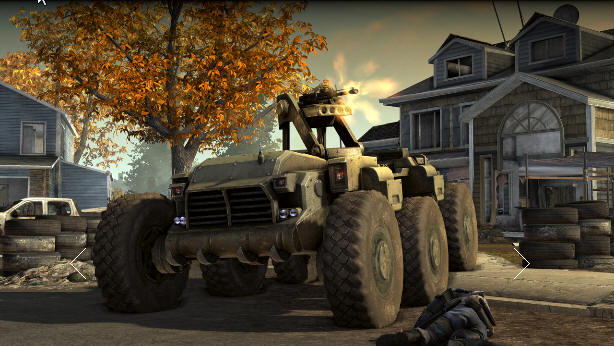Maybe I'm naive, but I honestly believe there was a point at which Homefront was destined to be something special. An FPS war game where the conflict was made intensely personal by staging it in America and waging it with real people? It's an arguably rock-solid concept.
The question then (and isn't the question always some variation on this?) is how did Kaos Studios and THQ go from that great germ of an idea to the brain-dead, dull and frankly pretty lousy final product they're releasing today?
In a story created by Hollywood screenwriter John Milius (Red Dawn), a reunited Korea has spread its influence throughout the world and, as of the year 2027, has begun occupying the United States. Step One of their occupation plan? Wreak havoc in strip malls and residential areas in an extremely specific way, so that the devastation left behind is incredibly linear video game levels. It's truly diabolical.
It's a tiny narrative ember in a big dark cave of missed opportunity.
One surly group of locals, tired of seeing their kids' elementary schools turned into choke points and cover spots, are taking a stand, nabbing some fuel trucks and bringing them to the U.S. military's resistance in San Francisco.
That mission (which occupies all but the game's last level) rarely plays out in a more interesting scenario than "clear the urban environment." You find some dudes, you shoot the dudes, you move on. Repeat for ... five or so hours. There's a variety of weapons, but none (save for the couple of shotguns) feel demonstrably different from the others, so no hope for excitement there. Nope, it's pretty much Dullsville top to bottom, save for the surprisingly excellent late-game helicopter stage.
There are monster closets. There are enemy wells. There are enemies that kill you with rocket launchers with no warning. Objectives are indicated by a compass and the word "Follow" that is ever-present over your squad leader (yes, through the whole game). There are so many lousy design choices, Homefront feels like a reunion tour for "Game Sins of the Mid 00s."
The hope then, with such pedestrian gameplay, is that the idea of everyday people battling in everyday American locations would be enough to buoy Homefront, but Kaos has undercut the impact of its own concept at nearly every opportunity.
The only thing I can figure is that the Koreans have turned the area outside San Francisco into some sort of Hooters/White Castle internment camp.
The characters couldn't be more stereotypical and their interactions couldn't be more cookie cutter. If they're average Joes protecting their homeland rather than super soldiers, they obviously haven't been informed about it; there's scarcely a moment of doubt, fear or real humanity to be found. There's a provocative moment involving a mass grave, but it's a tiny narrative ember in a big dark cave of missed opportunity.
Occasionally, when you notice you happen to be fighting on a Little League field or mall parking lot, you get a glimpse of Homefront's potential, but profoundly stupid in-game advertising is there to snatch it away just as quickly. The only thing I can figure is that the Koreans have turned the area outside San Francisco into some sort of Hooters/White Castle internment camp, so densely do they dot Homefront's retail landscape.
Still too immersive? Kaos has been kind enough to tattoo some of the game's most important locations with QR codes you can scan with your phone to get exclusive wallpapers and the like. Just, you know, while you're playing and being all immersed and stuff. There's no reason given. They're just there.
... I'm putting this sentence here on the off chance you're skimming. Go read the above paragraph, it tells you everything you need to know about the game.
If you get bored of tracking down QR codes, you can take a shot at the multiplayer, which is far more successful than the campaign. Though its modes aren't terribly interesting, it has spiced up the traditional formula in some interesting ways. Kills and completed objectives will earn battle points which you can use on the fly to spawn a better weapon or obtain jeeps, tanks and the like. The large scale battles with their shifting control points are reminiscent of MAG but with the added layer of controllable drones, tanks and copters.
Also, while kill streaks earn big, persistent bonuses, they also put a bounty and a large red marker on your head, which is a cool addition to the risk/reward formula. Those kill streaks differ depending on if you're on-foot or in a vehicle, another nugget of smart design.
It feels different from what's on offer from other games in the FPS market right now, but it's impossible to say whether or not that'll be enough to keep sustained interest in this crowded FPS market.
More puzzlingly, the pleasant multiplayer fails to capitalize on Homefront's citizen soldier premise in any way whatsoever.
As you'll notice in both the single and multiplayer modes of Homefront, you practically never interact with people who aren't directly involved in the war. Everyone's already fighting, only a couple sit on the sidelines to remind you what, precisely, you're fighting to defend. Kaos hasn't brought the war game into a context we can relate to, they've just turned the country into a war game.
As I slugged through my third Hooters, clearing a path to the nearby White Castle, I couldn't help but wonder: If, from the beginning, all the towns have been turned to video game levels and all the citizens to soldiers, why was I brought here in the first place?


